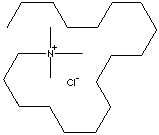PRODUCT IDENTIFICATION

H.S. CODE
TOXICITY
CLASSIFICATION
PHYSICAL AND CHEMICAL PROPERTIES (30% AQ. SOLUTION)
MELTING POINT
SOLUBILITY IN WATER
REFRACTIVE INDEX
APPLICATIONS
BASE
APPEARANCE
99.0% min
30% SOLUTION
APPEARANCE
0.8% max
FREE AMINE HCl
0.8% max
GENERAL DESCRIPTION OF PHASE TRANSFER CATALYSIS
'Phase transfer catalysis (PTC)' methodology is a powerful tool improving process efficiency, product selectivity and providing mild reaction conditions in organic chemical reactions. In many chemical reaction situations, there are different species (immiscible liquids or solid and liquid) which don't react each othrer due to separattion by an interface. Small quantity of ��phase-transfer catalyst��, involves a substrate (soluble in the organic layer) and an anionic reagent or a nucleophile (dissolved in the aqueous layer), extracts one of the reactants, most commonly an anion, across the interface into the other phase where reaction can take place with the substrate and reaction can proceed. The quaternary ammonium salts can carry the nucleophile from the aqueous to organic phase and are used as the most commonly used as phase-transfer catalyst. The phosphonium derivatives favoring higher thermal stability property are also used. Crown ethers and polyethylenglycol compounds are also widely used in this application.
- Mercuric Chlorides
- Formaldehyde
- 8-Hydroxyquinoline
- Copper Hydroxide
- Cresol
- Alcohols (Ethyl Alcohol Isopropyl Alcohol)
- Iodines / Iodophors
- Chlorine releasing compounds
- Gluteraldehyde
- Phenolics
- Quaternary Ammonium Compounds